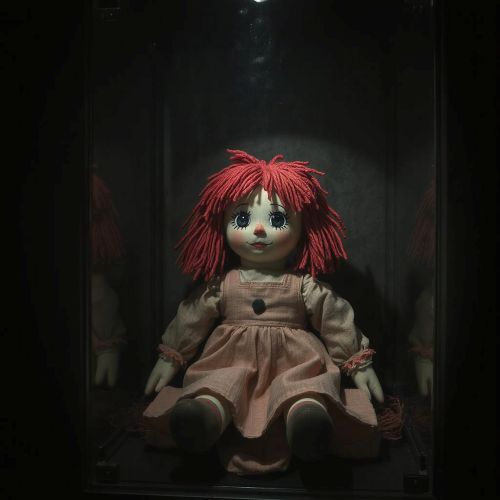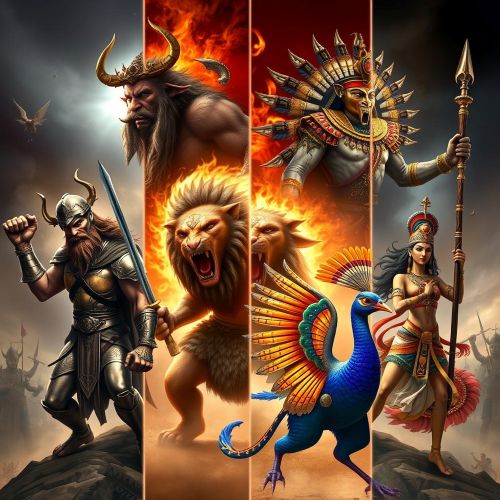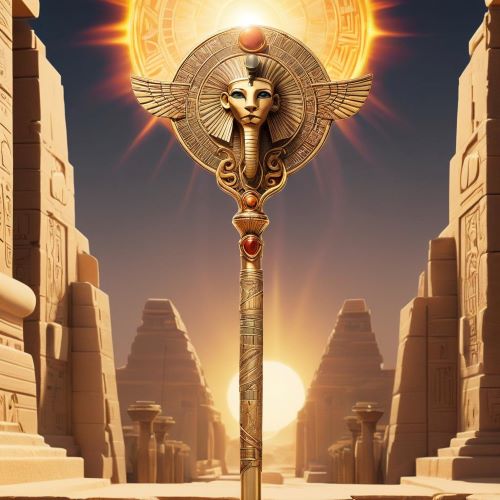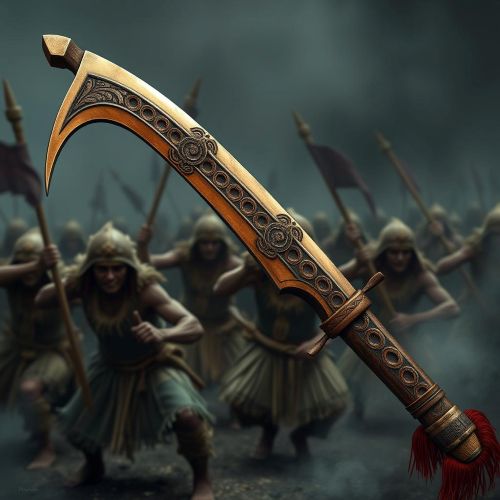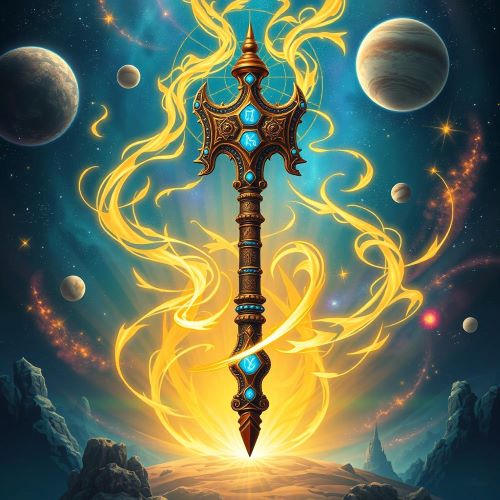Kavacha and Kundala : The Divine Armour
Kavacha and Kundala
Introduction
Origins
Kavacha and Kundala, bestowed upon Karna at birth by the Sun God Surya, are among the most iconic symbols in Indian mythology. These divine gifts, described in the Mahabharata, endowed Karna with invulnerability, setting him apart as a nearly unbeatable warrior. The Kavacha, a protective armor, and the Kundala, celestial earrings, were not mere ornaments but powerful symbols of divine favor, highlighting Karna’s extraordinary strength and connection to his celestial lineage.
The Kavacha, rooted in Vedic texts like the Atharva Veda, is depicted as impenetrable armor crafted from divine materials, impervious to both mortal and celestial weapons. It reinforced Karna’s invulnerability, ensuring his protection in battle, while symbolizing the larger cultural belief in divine intervention and protection. The Kundala, equally significant, enhanced Karna’s power and stood as a mark of his divine heritage. In Hindu tradition, earrings often symbolize wisdom and grace, and the Kundala carried with them not just physical strength but spiritual enlightenment.
Together, the Kavacha and Kundala shaped Karna’s destiny, marking him from birth as someone fated for greatness, influenced by the gods themselves. These gifts not only elevated his prowess but also wove a narrative of divine influence in his life, reflecting the belief that celestial forces play a crucial role in human affairs, guiding individuals toward their destiny from the moment they enter the world.
Think you know your myths and legends? Dive into the world of ancient stories and test your knowledge with our engaging quizzes on Mythlok!
Powers
The Kavacha and Kundala were far more than mere armor and jewelry; they were divine gifts that granted Karna nearly unmatched power. The Kavacha offered absolute protection from all weapons, and the Kundala ensured no harm could befall him while he wore them. These gifts made Karna a pivotal figure in the Mahabharata, capable of shifting the balance of any battle he fought in. His invincibility, thanks to these divine blessings, shaped his role in the epic, elevating him into a nearly mythical figure whose fate was deeply intertwined with the powers bestowed upon him.
The Kavacha, crafted with divine impenetrability, shielded Karna from even the most powerful celestial attacks, making him an almost invincible warrior. This unyielding protection added a psychological layer to his battles, instilling fear in his enemies, who knew they faced a foe they could not harm. Karna’s combat prowess, enhanced by this armor, was extraordinary, allowing him to dominate in battle. His enemies feared not just his skill but the knowledge that his divine protection made him nearly untouchable, lending a sense of awe and intimidation to his presence on the battlefield.
Complementing the Kavacha, the Kundala offered more than physical protection—it amplified Karna’s strength and gave him a divine aura that inspired both admiration and fear. These celestial earrings imbued him with an otherworldly charisma that influenced how others perceived him, both as a leader and as a warrior. Together, the Kavacha and Kundala formed a complete system of protection, blending physical and metaphysical power to create a nearly invincible force. Yet, in the larger narrative of the Mahabharata, they also symbolized the complex interplay between fate and power, with their role in Karna’s eventual downfall reflecting the tragic reality that even the most blessed are not immune to the inescapable tides of destiny.
Owners/Users
The Kavacha and Kundala were integral to the character of Karna, the son of Surya and Kunti, in the Mahabharata. Born with these divine gifts, Karna’s golden armor and earrings became symbols of his unparalleled strength and tragic fate. His loyalty to Duryodhana and the Kauravas, despite knowing the consequences, highlighted his sense of duty and honor. These celestial gifts from Surya made him an invincible warrior, capable of standing against the greatest of foes. Yet, they also underscored the duality of his life—a powerful hero bound by destiny.
Beyond Karna, the Kavacha and Kundala hold significance across Hindu mythology. The “Shiva Kavacha,” for instance, is connected to the god Shiva and is believed to grant invulnerability to its wearer. The Kundala, too, has links to other deities like Vishnu and Krishna, showing its importance in various mythological narratives. While Karna is the most prominent owner of these divine items, their association with multiple gods suggests their widespread spiritual and cultural value in protecting and empowering divine figures.
One of the most poignant moments in the Mahabharata involves the Kavacha and Kundala’s pivotal role in Karna’s eventual downfall. Indra, the king of gods and father of Arjuna, approached Karna disguised as a Brahmin, requesting these divine gifts as alms. True to his generous nature, Karna gave them away without hesitation, unaware that doing so would make him vulnerable in the upcoming battle. This act of selflessness sealed his tragic fate, as it stripped him of his invincibility and left him exposed in the Kurukshetra war, symbolizing the bittersweet consequences of both generosity and destiny.
Instances used
Throughout Indian mythology, the Kavacha and Kundala have played crucial roles in various narratives, especially in the Mahabharata. One of the most compelling stories occurs during the monumental Kurukshetra war, where Karna’s invulnerability, granted by his divine armor, became a primary concern for the Pandavas. To create a more balanced battlefield, Lord Indra, the king of the gods and father of Arjuna, devised a clever plan to strip Karna of his precious gifts.
Disguised as a Brahmin, Indra approached Karna and asked for the Kavacha and Kundala as alms. True to his character, which embodied virtue and generosity, Karna selflessly relinquished his divine armor and earrings. This act, while showcasing his noble spirit, ultimately sealed his fate, leaving him exposed in battle without the protective powers that had once made him nearly invincible.
The significance of the Kundala extends beyond Karna, as it symbolizes a conduit for divine energy and blessings. Legends suggest that these earrings harnessed celestial forces, enhancing the spiritual connection between gods and mortals. As such, they served as a vital source of protection and empowerment for various heroes in mythological tales. However, with the loss of the Kavacha and Kundala, Karna’s once formidable presence in battle diminished. His vulnerability during the Kurukshetra war led to his tragic downfall at the hands of Arjuna, underscoring the profound impact of these divine gifts on his destiny and the overarching narrative of the epic.
Source
Gupta, R. D. (2012). The Mythical Armor: Kavacha and Kundala in Hindu Mythology. New Delhi: Lotus Press.
Rao, P. (1988). Hindu Armaments and Iconography. Chennai: K. R. S. Publications.
Wikipedia contributors. (2023). “Indian Armor.” Wikipedia, The Free Encyclopedia. Retrieved from https://en.wikipedia.org/wiki/Indian_armour.
Fictspedia. (2024). “Karna’s Armor.” Retrieved from https://fictspedia.fandom.com/wiki/Karna%27s_Armor.
“A Study of Weapons in Hindu Mythology: Protection and Power.” Journal of Indian Religion, 2020.
Desai, M. (2023). “Understanding the Symbolism of Hindu Jewelry.” Indian Journal of Cultural Studies.
Hiltebeitel, Alf. The Ritual of Battle: Krishna in the Mahabharata. State University of New York Press, 1990.
Karve, Irawati. Yuganta: The End of an Epoch. Disha Books, 1991.
Narayan, R.K. The Mahabharata: A Shortened Modern Prose Version of the Indian Epic. University of Chicago Press, 1978.
Menon, Ramesh. The Mahabharata: A Modern Rendering. iUniverse, 2004.
“Karna: The Tragic Hero of Mahabharata.” Hindu Mythology, 2023. https://hindumythology.com/karna-tragic-hero-mahabharata
“Mahabharata: Karna’s Life and Legacy.” Epic Stories of India, 2022. https://epicstoriesindia.com/mahabharata-karna-life-legacy
Frequently Asked Questions
Lorem ipsum dolor sit amet, consectetur adipiscing?
Lorem ipsum dolor sit amet, consectetur adipiscing elit. Praesent convallis vestibulum justo, ac tincidunt nunc vehicula quis. Nullam id dolor quis orci malesuada feugiat. Curabitur aliquet libero at urna ullamcorper, ac ultricies nulla dapibus.
Lorem ipsum dolor sit amet, consectetur adipiscing?
Lorem ipsum dolor sit amet, consectetur adipiscing elit. Praesent convallis vestibulum justo, ac tincidunt nunc vehicula quis. Nullam id dolor quis orci malesuada feugiat. Curabitur aliquet libero at urna ullamcorper, ac ultricies nulla dapibus.
Lorem ipsum dolor sit amet, consectetur adipiscing?
Lorem ipsum dolor sit amet, consectetur adipiscing elit. Praesent convallis vestibulum justo, ac tincidunt nunc vehicula quis. Nullam id dolor quis orci malesuada feugiat. Curabitur aliquet libero at urna ullamcorper, ac ultricies nulla dapibus.
Lorem ipsum dolor sit amet, consectetur adipiscing?
Lorem ipsum dolor sit amet, consectetur adipiscing elit. Praesent convallis vestibulum justo, ac tincidunt nunc vehicula quis. Nullam id dolor quis orci malesuada feugiat. Curabitur aliquet libero at urna ullamcorper, ac ultricies nulla dapibus.
Lorem ipsum dolor sit amet, consectetur adipiscing?
Lorem ipsum dolor sit amet, consectetur adipiscing elit. Praesent convallis vestibulum justo, ac tincidunt nunc vehicula quis. Nullam id dolor quis orci malesuada feugiat. Curabitur aliquet libero at urna ullamcorper, ac ultricies nulla dapibus.


